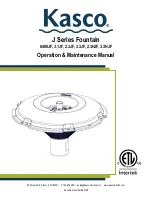
LiquidArt, LLC
401 S. Redwood St.
Canby, OR 97013
Pump Service and Maintenance
Periodically inspect and clean the pre-filter. To clean, remove the pre-filter from the water pump and rinse
using clean water. Replace the pre-filter if it is damaged or torn.
The cap over the impeller should occasionally be removed to clean and inspect the impeller assembly. The
impeller is the only serviceable item and can be pulled out of the pump body. Do not take the impeller apart. If
it is worn or broken, the entire impeller assembly should be replaced. This will restore the pump to its original
capacity. Pumps taken out of service for an extended period with fluid inside run the risk of forming a crust,
which may prevent subsequent starting. Do not use salt water in your water reservoir. Always check the
electrical cord for sharp bends, which can cause premature cracking. Do not use the power cord to lift or move
the pump.
Electrical Precautions
Always use a properly grounded outlet. Do not immerse the pump plug in water. If the plug falls
into the water, DO NOT REACH INTO THE WATER TO REMOVE THE PUMP PLUG. TURN OFF THE
CIRCUIT FIRST! A “drip loop” should be used. The “drip loop” is a loop in the electrical cord below
the level of the receptacle or plug, which prevents water from traveling along the cord. The
National Electric Code requires that a ground fault circuit interrupter (GFCI) be installed in the
branch circuit supplying fountain or pond equipment. LiquidArt has several styles of GFCI units
available.
WARNING: NEVER REMOVE THE GROUND PIN FROM THE ELECTRICAL PLUG. FOR YOUR
PROTECTION, ALWAYS UNPLUG THE PUMP UNIT FROM ITS POWER SOURCE BEFORE
INSTALLING OR SERVICING YOUR FOUNTAIN. SHOULD THE UNIT APPEAR TO NOT BE
WORKING PROPERLY, DO NOT REACH FOR, REMOVE, OR DISASSEMBLE THE PUMP
BEFORE YOU DISCONNECT THE POWER
!
Additional Notes:
When first running your LiquidArt fountain, you may notice some “soap-like bubbles” building up
on the fountain base (at the bottom of the rocks). This is normal and should lessen over time,
disappearing altogether in approximately 2-3 weeks of regular use.
Also, you may notice a slight “whitening” of the bubbler along the water fall pattern. This is
generally caused by either “hard” water (calcium deposits) or slight concrete dust/residue on the
rocks from the manufacturing process. This will go away over time, unless it’s caused by “hard”
water, in which case, a water softener can be used to minimize the effects of the calcium
deposits. This is not unique to faux rocks, and can appear on natural stones and pottery pieces as
well. In either case, it should not be visible when water is cascading over the bubbler.
If you have any additional questions, please call LiquidArt, at (800) 974-9586. Thank you for
your business!


























